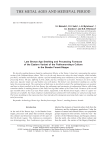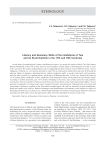Archaeology, Ethnology & Anthropology of Eurasia @journal-aeae-en
Статьи журнала - Archaeology, Ethnology & Anthropology of Eurasia
Все статьи: 524

Late Krotovo (Cherno-ozerye) burials with casting molds from Tartas-1, Baraba forest-steppe
Статья
Бесплатно
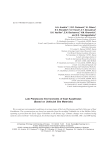
Late Pleistocene environments of East Kazakhstan (based on Ushbulak site materials)
Статья научная
We reconstruct environmental conditions at various stages of the Late Pleistocene and Early Holocene of East Kazakhstan. The reconstructions are based on materials from the stratified Ushbulak site in the Shilikta Valley, spanning a period from the Early Upper Paleolithic to the Bronze Age. Climatic changes were evaluated using natural science methods-mineralogical, ZooArchaeology by Mass Spectrometry (ZooMS), OSL- and AMS-dating, etc. Sevaral stages, relating to environmental changes, are evaluated. The fi rst period (~52–37 ka BP) was period of moderately warm and relatively humid climate, with predominantly forest-steppe, meadow-steppe, and semidesert landscapes. The second period (~25–21 ka BP) coincided with a transition from a moderately warm to a very cold and more arid climate dominated by steppes. The third period (~18–16 ka BP) was transitional from the glacial maximum to the postglacial interstadial, with a relatively cool and arid climate and mostly steppe and forest-steppe landscapes. The fourth period (~15–14 ka BP) was characterized by the warmest climate in the Late Pleistocene; steppe and forest-steppe vegetation dominated. During the latest, Early Holocene period, the climate was warm and humid, with savanna-like landscapes. The analysis of natural-climatic conditions allows us to conclude that the early stage of the site’s functioning, characterized by the highest intensity of settlement, was optimal for ancient man.
Бесплатно

Статья научная
Here, we present initial results of a new course of research being carried out at the Moiltyn-am, Orkhon-1, and Orkhon-7 Paleolithic sites in the Orkhon River Valley, central Mongolia. Our research focuses on the Moiltyn-am site, which preserves a cultural and chronological sequence from the Final Middle to the Late Upper Paleolithic. Results from analyses of rare earth elements, Strontium (Sr) isotopes, and faunal assemblages are correlated with data on paleoenvironmental conditions in the region during MIS-3 and MIS-2. Our conclusions are based in part upon post- depositional changes detectable in archaeological material from cultural layers at the Moiltyn-am site revealed through convergent analyses of stratigraphy, sedimentology, planigraphy, and the comparison of Sr isotopes in sediments and osteological remains. XRF-derived geochemical data from the Moiltyn-am sedimentary sequence yields evidence of past climatic conditions. We correlated these data with human occupational episodes in the Orkhon Valley during the Middle and Upper Paleolithic, and the results are analyzed in the context of extant paleoenvironmental information from northern Mongolia. Our results indicate a relatively humid climate prevailed during MIS-3, followed by a period of aridification, and the redeposition of sediments at Moiltyn-am. Faunal analysis reveals that Bos sp. and equids were the principal prey species for humans in the Final Middle to Initial Upper Paleolithic, supplemented by members of the Caprinae during the Early Upper Paleolithic. A complex mammoth fauna inhabited forest-steppe and steppe landscapes in the Khangai Mountains during MIS-3 and MIS-2.
Бесплатно
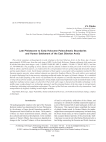
Статья научная
This article examines archaeological records relating to the East Siberian Arctic in the Stone Age. It spans approximately 50,000 years, from the early stage of MIS 3 to the Early Holocene. Human settlement of the region can be divided into three main stages: early (~50,000–29,000 BP, MIS 3), middle (~29,000–11,700 BP, MIS 2), and late (11,700–8000 BP). The peopling of Arctic Eurasia and the cultural evolution in that part of the world were driven both by abiotic and biotic factors, as evidenced by the correspondance between archaeologically detectable changes and key paleoclimatic events. Early human settlement of that region is associated with a population marked by West Eurasian genetic ancestry, whose cultural elements are typical for Southern Siberia. The early settlers were replaced by people displaying East Asian ancestry, migrating northwards under the impact of climatic changes. It is concluded that the successful peopling of the Arctic was facilitated by the adoption of critically important innovations such as sewing with eyed bone needles, and manufacture of long shafts and pointed implements made of mammoth tusks. Lithic industries marking various stages are described. That of the early stage is characterized by fl ake technology; in the middle stage, wedge-shaped core technology appeared; and the principal feature of the late stage is microprismatic technology, indicating total population replacement. The onset of the Holocene coincides with a key innovation—land transportation by dogsled, resulting in much higher mobility.
Бесплатно

Статья научная
This paper briefl y reviews the main Late Upper Paleolithic sites of the Upper Yenisei—in the South Minusinsk Basin and in the adjacent highlands of the West Sayan. Known sites mostly date to the Late Sartan period. They concentrate on the Upper Abakan River, in the Yenisei valley between Maina and Sayanogorsk, and on the Upper Tuba River. Information is provided on the composition of fauna and on pollen data, indicating the predominance of mosaic landscapes with alternating forested and open steppe spaces. Climate fl uctuations of the Final Pleistocene were refl ected in the alternation of phases of herbaceous and forest vegetation. The association of most sites with deposits of the second and third terraces has been established. Certain sites, however, are associated with cover deposits at high elevations, on the one hand, and with the fi rst terrace lowered to the level of the high fl oodplain, on the other. In recent years, the Late Paleolithic of the Upper Yenisei has been considered in the context of the original version of catastrophic fl oods, which presumably occurred repeatedly in the Late Pleistocene. The nature of the stratigraphic sections of the multilayered sites of the Maina group on the Yenisei, however, disagrees with this hypothesis, and indicates continuous alluvial sedimentation in the Sartan Age. A conclusion is made about the predominance of remains of seasonal huntergatherer habitation sites on the riverbanks. But there are also traces of a lithic workshop near the quartzite outcrops (Kuibyshevo II). Unfortunately, no sites earlier than the Late Upper Paleolithic are known in the region, and Mesolithic ones are extremely rare.
Бесплатно

Levantine Middle Pleistocene blade industries
Статья научная
The origin of Near Eastern Middle Pleistocene blade industries is discussed with reference to the Levallois reduction-technique. Special attention is paid to the Gesher Benot Ya'akov site, in Israel, where the Levallois technology is the earliest in the region (ca 800 ka BP). Whereas later Acheulean industries show no continuity with the Levallois tradition, the alternation of predominant Middle Pleistocene technologies indicates changing adaptation strategies caused by ecological conditions. Accordingly, the early appearance of the laminar technology in the Near East evidences local evolution rather than immigration. The major factors underlying this innovation were adaptation and the intrin sic development of the Levallois system. Laminar technologies, which are fi rst evidenced by certain Levantine sites even earlier than Gesher Benot Ya'akov, became widely distributed at the Acheulo-Yabrudian stage of the late Acheulean. A well-developed blade technology is demonstrated by the Amudian industry of Qesem, Israel, dating to 400–200 ka BP.
Бесплатно
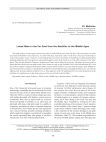
Lobed Ware in the Far East from the Neolithic to the Middle Ages
Статья научная
The study focuses on the origin and survival of the so-called lobed ware in the Far East. The term refers to vessels decorated with shallow vertical grooves, less often with deep, wide dents, either on the most convex part of the body or on the entire surface. Some vessels are covered with groups of vertical carved lines or burnished, less often painted bands imitating lobulation. Such ceramics are especially frequent at sites of the Jurchen era (7th–13th centuries) in the Amur basin. They are also found in Primorye, northeastern China, and in adjacent territories. The study of various sources shows that the lobed ware was made on the Lower Amur as early as the Neolithic (5th to late 2nd millennia BC), with the earliest samples relating to the Kondon culture. Typical lobed ceramics were also made by people of the Malyshevo and Voznesenovskoye cultures. It is hypothesized that the Jurchen-Bohai pottery, including the lobed ware, was directly influenced by Korean traditions of the first two or three quarters of the 1st millennium AD. Given the distinctness of the tradition, its reminiscences in the Amur region can be traced back to the Neolithic.
Бесплатно

Location of Tatar settlements in the Middle and Lower Tara region according to 18th century maps
Статья
Тhis article discusses the location of Tatar settlements in the lower and middle reaches of the Tara on maps of the Tarsky Uyezd (1784 and 1798) and on topographic plan of the Kartashevskago and Bergamotskaya districts of the Tarsky Uyezd (1798). These maps had not been previously used for reconstructing the history of the region. To test their accuracy, other sources are used, including the Inventory Book of the Tarsky Uyezd, Gerhard Miller’s itineraries, etc., as well as the results of archaeological and ethnographic studies. Based on the analysis of maps, patterns in the locations of Tatar settlements are reconstructed. They were situated between the mouth of Tara and its confl uence with the Chertalinka River on the right bank, and between the Chertalinka and Kalinka rivers on the left bank. The reliability of the late 18th century maps as sources of information about the winter and summer settlements of the Tatars of the Middle and Lower Tara is assessed. These maps do not suggest that the settlements were still seasonal rather than permanent at that time. The winter camps were situated on the Tara high terrace, away from the valley, and summer camps were on the fl ood plain, close to the villages. The general pattern was that people settled along the river, often close to the places where the Tara tributaries fl owed into it. Place names are suggestive of seasonal settlements. Comparison with modern maps suggests that the current settlements pattern on the Lower and Middle Tara emerged in the late 18th century.
Бесплатно

Materials from dwelling 2 on Suchu island, the Lower Amur (1977 season, excavation III)
Статья
This article presents the fi nal results of excavations at one of the largest Neolithic sites in northeastern Asia— a settlement on Suchu Island on the Amur. Most of the rich collection (3967 spec.), owned by IAET SB RAS (stone tools, ceramics, ornaments, and artistic and ritual artifacts), has not been described before. This publication focuses on the analysis of artifacts from dwelling 2 (excavation III, 1977). We describe the construction of this semi-underground dwelling, circular in plan view. The typological analysis of the lithics indicates a complex economy. Many of them (arrowheads, projectile points, inserts, knives, plummets) relate to hunting and fi shing, and to processing carcasses (end-scrapers, scrapers, burins, combination tools), others are chopping tools. The distinctive feature of the lithics is that some are bifacial. The analysis of the ceramics suggests that they belong to the Late Neolithic Voznesenovskoye culture. The use of binocular microscopy allowed us to assess the technological and constructive properties of the ceramics, as well as their morphological, decorative, and functional features. Non-ut ilitarian artifacts shed light on the worldview of the Suchu people. The collection dates to the mid-second millennium BC.
Бесплатно

Medieval burials at Ryabchikov Klyuch-1, the Kansk-Rybinsk basin
Статья научная
Previously, burials at Ryabchikov Klyuch-1 on the Kan River near Kansk were dated to the Late Middle Ages (pre-Russian period) and attributed to an autochthonous group. In 2015, two burials were discovered at the cemetery, with the remains of an adolescent girl and a child. A comprehensive analysis of the burial rite and grave goods suggests that the burials date to the 12th century. Numerous archaeological and ethnographic parallels were found. Morphologically, the girl’s cranium reveals generally eastern traits, specifically those common in Western Siberian (Uralic and Ob-Irtysh) populations. The cranium was restored, and a graphical reconstruction of the face was made. Burial practices of the 17th–19th century Middle Kan populations are described. They were Ket-speaking Kotts, Turkic-speaking Karagas, and Samoyed-speaking Kamasins. The analysis of sources suggests that the buried people were likely ancestors of the Kotts.
Бесплатно



